Women are at a higher risk for osteoporosis, osteoarthritis, and rheumatoid arthritis compared to men, largely due to sex hormones.
Both men and women achieve their peak bone mass in their early 20s. However, there are structural and size differences in bones between genders, and hormones influence bone development, leading to varying risks for musculoskeletal diseases.
Osteoporosis
Osteoporosis is a condition characterized by the loss of bone mass, making bones thin and weak, and more prone to fractures over time. This condition is often caused by calcium deficiency, particularly prevalent in older adults. For some individuals, this process accelerates, increasing their risk for osteoporosis.

Women are more susceptible to osteoporosis and fractures due to lower bone density than men.
Osteoporosis affects both men and women. However, women are more vulnerable to osteoporosis and fractures related to lower bone density compared to men.
Estrogen deficiency also contributes to the development of osteoporosis in women, occurring at a younger age compared to men. After the age of 50, women experience more fractures than men due to bone loss. However, before age 50, men have a higher fracture rate due to greater risk factors.
Osteoarthritis
Osteoarthritis is more common in older women than in older men. Women also tend to experience more severe arthritis compared to men.
Women are generally affected more due to hormonal and biological mechanisms. In terms of hormones, the decline of estrogen and testosterone plays a role in the development of arthritis in women. The risk of developing arthritis significantly increases right after menopause.
Testosterone is produced in the ovaries, so during menopause, testosterone levels are lower. This hormone helps build and strengthen muscles. As levels of this hormone decrease, women face a greater risk of developing arthritis.
Women typically have wider hips, more flexible joints, and better mobility for functions related to pregnancy and childbirth. The effects of childbirth contribute to the development of arthritis and increase the risk of this disease among women.
Rheumatoid Arthritis
Conditions such as ankylosing spondylitis, psoriatic arthritis, and rheumatoid arthritis affect multiple joints and develop due to an overactive and malfunctioning immune system. These autoimmune diseases cause chronic inflammation that can lead to joint and tissue damage.
Women tend to experience rheumatoid arthritis more frequently than men. This is linked to sex hormones and women’s responses to infections and environmental stressors.
High levels of estrogen in women can cause the immune system to malfunction and attack the body through a misdirected response known as autoimmunity. Estrogen enhances B cells (immune cells), which can lead to immune system dysfunction. Furthermore, estrogen may increase the production of certain inflammatory proteins, contributing to arthritis.
The X chromosome plays a role in the development of autoimmune diseases. Women have two X chromosomes, while men have only one, which increases their risk of these diseases.
Both genders can slow down bone loss and reduce the risk of musculoskeletal diseases by maintaining a healthy diet rich in calcium and vitamin D, exercising regularly, avoiding smoking, and moderating alcohol consumption.





















































